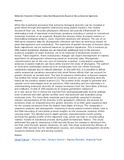| dc.contributor.author | Patrick, Okoth | |
| dc.contributor.author | Muoma, John | |
| dc.contributor.author | Dennis, Omayio | |
| dc.contributor.author | Mustafa, Barasa | |
| dc.contributor.author | Paul, Angienda | |
| dc.date.accessioned | 2021-06-03T14:04:43Z | |
| dc.date.available | 2021-06-03T14:04:43Z | |
| dc.date.issued | 2018-10 | |
| dc.identifier.uri | https://doi.org/10.4236/AJMB.2018.84019 | |
| dc.identifier.uri | https://www.scirp.org/journal/paperinformation.aspx?paperid=88168
https://doi.org/10.4236/ajmb.2018.84019 | |
| dc.identifier.uri | http://r-library.mmust.ac.ke/123456789/1585 | |
| dc.description.abstract | While the mutational processes that subsume biological diversity can be revealed in great detail through phylogenetic inferencing using plastid markers, few studies document their use. Accurate phylogenic inference can provide a framework for addressing a host of important evolutionary questions including a context to reconstruct molecular evolution of an organism. Despite the obvious utility of plastid markers in illuminating biological enquiry, many important questions still abound. The use of cp-DNA gene sequence data for phylogenetic inference can have an enormous impact on plant phylogenetics and systematics. The repertoire of genetic diversity of Kenya’s Gene Bank repositories can be explored based on cp-genome signatures. This is because cp-DNA-based mutational changes are an important additional tool to the previous evidence available on plant evolution yet to be explored in biodiversity studies in Kenya. Taken together, these evolutionary changes can inspire development of realistic algorithms for phylogenetic inferencing based on molecular data. Phylogenetic reconstructions are at the very core of molecular evolution. Comparative sequence analyses of plastid markers can have utility beyond the study of phylogeny. The pattern of nucleotide substitution observed over evolutionary time can reflect functional constraints imposed due to natural selection. In line with this, it is possible to detect subtle anatomical variations associated with small fitness effects that can account for genetic diversity at varietal level. The lack of sequence information in Kenyan cowpea has limited the robust advancement of molecular markers use in dissecting diversity based on the putative plastid markers [1]. The present study sought to generate and upscale novel technologies such as genomics, DNA barcoding and bio-informatics in understanding molecular diversity of cowpea accessions from the Gene Bank of Kenya and ecotypes. A total of 298 sequences of cowpea germplasm conserved as in situ and ex situ in Kenya but sourced from phylogeographically diverse settings were examined and their genetic profiles were characterized and evaluated using molecular tools. The Gene Bank materials were purposefully sampled to develop subsets representative of the diversity in the genepool’s collection. We present an extensive study on characterizing the genetic diversity of cp-DNA gene sequence data for the cowpea accessions from the Nation Gene Bank of Kenya. The comparative sequence analyses and phylogenetic clustering of seven plastid markers widely used in the DNA barcoding of land plants provide insights on the molecular evolution of this vascular plant. The detailed and in-depth genome characterization herein greatly enriches the genetic profile of this important crop, which can help in reconstructing realistic models of mutational process during plant evolutionary history. This study addressed this gap by employing a DNA barcode library for cowpea to determine the loci that yield the best species resolution. As well, this study examined the efficacy of custom DNA barcode loci for identification success, and compared phylogenetic diversity measures between sites and among variants. | en_US |
| dc.language.iso | en | en_US |
| dc.publisher | American Journal of Molecular Biology | en_US |
| dc.subject | Molecular, Footprint, Gene ,Bank ,Repositories,cp-Genome Signatures | en_US |
| dc.title | Molecular Footprint of Kenya’s Gene Bank Repositories Based on the <i>cp</i>-Genome Signatures | en_US |
| dc.type | Article | en_US |

